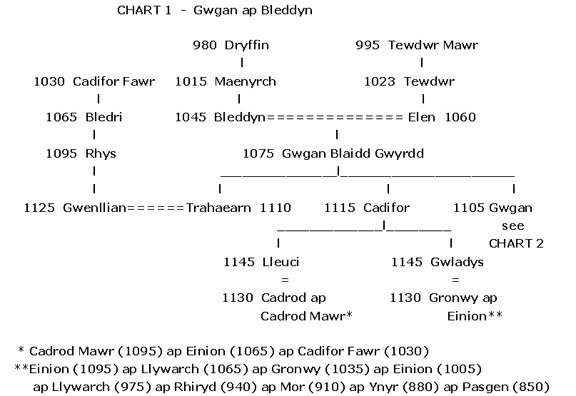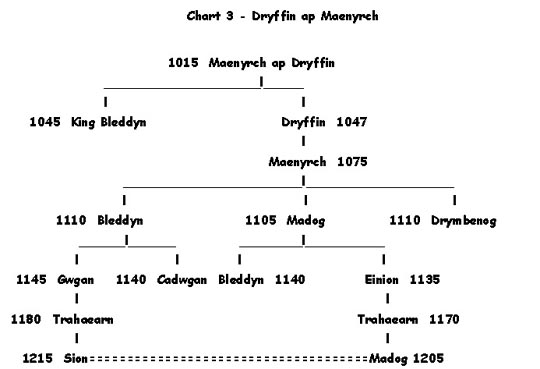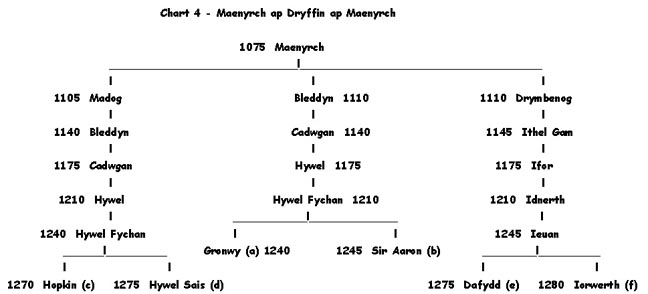BLEDDYN ap MAENYRCH, KING of BRYCHEINIOG
By
Darrell Wolcott
Bleddyn ap Maenyrch
ap Dryffin was king of Brycheiniog until 1093, the year that Norman Marcher Lord Bernard Newmarch's army killed him.
Although Bleddyn's wife's brother, King Rhys ap Tewdwr of Deheubarth [1], came to his assistance, both Welsh kings died in
the ensuing battles. While the early antiquarians recorded the history correctly, they were careless with the pedigrees
they cast for Bleddyn's family.
Most sources, including
Peter Bartrum's charts, describe two brothers, Trahaearn and Cadifor, as sons of "Gwgan ap Bleddyn". Anyone, who did
the requisite work to establish the timeline, could demonstrate that the Trahaearn ap Gwgan who married Gwenllian ferch Rhys
ap Bledri [2] WAS NOT a brother of the Cadifor ap Gwgan who married Mallt ferch Llewelyn Fychan ap Llewelyn ap Gwrgan [3].
In fact, this Trahaearn WAS a son of Gwgan ap Bleddyn, while that Cadwgan was a full generation younger, as shown by the following
charts:


Bartrum played games
with his generational dating system to make it seem there was no missing generation here. Had he correctly assigned
Bleddyn to his Generation 1 (about 1030), the missing generation would be obvious. He DID place Bleddyn's wife (Elen,
sister of Rhys ap Tewdwr) in his Generation 1, but labeled Bleddyn as born in Generation 2 (about 1070). We suggest the opposite
was true, that Bleddyn was born c. 1045 and Elen near 1055
OUR EARLIER LOOK AT THIS FAMILY:
In 2011. we published
a paper on Einion ap Llywarch [4]which included a chart showing the marriage of Catryn ferch Sir Elidyr Ddu with Gruffudd
Gwyr ap Cadifor. We noted that there was a full generation missing in those citations which claim "Gruffudd Gwyr ap
Cadifor ap Gwgan ap Bleddyn ap Maenyrch". Some years later, we added a note to that chart to disclose:
"NOTE: Subsequent research indicates the son of Bleddyn was called Gwgan Blaidd Gwyrdd (the green wolf)
and his son was Gwgan ap Gwgan born c. 1105"
Since this is our first subsequent paper to mention this family, we should explain why we came to the conclusion asserted
in this notice. Almost all the source authorities known to us say the father of both of the men named Trahaearn in our
two above charts, and the father of both of the men named Cadifor, was named Gwgan. It is not chronologically possible
that this was a single Gwgan, so a "Gwgan ap Gwgan" seems to be indicated. There is, however, an outlier citation found
in Llyfr Baglan, 316 and repeated in Burke's Commoners, vol 3 page 176, which claims this ancestry:
"Einion Sais ap Rhys ap Hywel ap Trahaearn ap Gwgan ap Blegwryd ap Bleddyn ap Maenyrch".
While this citation contains the correct number of generations between the c. 1225 Einion Sais and the c. 1045 Bleddyn, the
overwhelming weight of evidence tells us that the son of Bleddyn who was the ancestor of Einion Sais, was actually named Gwgan.
Thus we explored the possibility that this pedigree had cited the man by his nickname, but contorted it into the rare male
name "Blegwryd" (alternately spelled Blegywryd). What possible nickname might yield to such a tortured misspelling?
We could understand "gwyrdd" or "green" being mistaken for "gwryd", but what was added to such a nickname to account for the
"bl" initial sound?
Another outlier citation in Dwnn ii, 43 traces this line to "Rhys ap Hywel ap Trahaearn ap Gwgan ap Blaidd ap Gwirydd ap Bleddyn",
which incorrectly inserts three generations between Trahaearn and Bleddyn. However, if we delete one "ap", we'd have
"Blaidd Gwirydd" or "wolf" plus a minor misspelling of the Welsh word for "green". Dwnn ii,
38 actually deletes that "ap" with the pedigree rendered as "Gwgan ap Blaidd Gywrydd ap Bleddyn", a lesser misspelling
of "green". Thus, we would identify "Gwgan Blaidd Gwyrdd" (Gwgan green wolf) as the son of Bleddyn and the father
of another Gwgan.
The probable ancestry of Bleddyn ap Maenyrch was charted in a prior paper [5] and will not be rehashed here.
SIBLINGS OF BLEDDYN:
No sisters are cited for Bleddyn. He had a younger brother, Drymbenog born c. 1050, who is the subject of another paper
on this site. [6]
Bleddyn had another brother, Rhiwallon, born c. 1046, whose wife is not known. He may have died before 1093 and left
a son, Ifor, born c. 1075. This line ended with a daughter, unnamed but born c. 1110, who married Robert (1095) ap Bledri
(1065) ap Cadifor Fawr (1030). [7]
The final sibling of Bleddyn was Dryffin, discussed below.
SONS OF BLEDDYN:
No daughters are cited for Bleddyn, but his eldest son was the Gwgan we have dubbed "green wolf". We suggest that this
boy, about age 17 when his father was killed, was deemed to be no threat to contend for kingship and perhaps even given
a young Norman lady for his wife when he reached his late 20's. It is not known how or why he earned his nickname.
Bleddyn also had a younger son, Caradog, who was under age 14 when their father was killed. He appears to have
also been treated kindly by the conquering Normans, as he later married and had sons, Ithel and Rawlff. Caradog had
likely married a Norman lady, which accounts for naming a son "Ralph", a distinctly non-Welsh name. King Bleddyn did
NOT have a son named Cadwgan.
ANOTHER BLEDDYN
ap MAENYRCH:
King Bleddyn had a brother, Dryffin ap Maenyrch, who named a son Maenrych, born c. 1075. That later Maenyrch had sons
Madog, Drymbenog and Bleddyn. That c. 1110 Bleddyn ap Maenyrch had sons Gwgan and Cadwgan:

The c. 1110 Drymbenog ap Maenyrch had a son, Ithel Gam born c. 1145, whom Bartrum charted as a son of the c. 1050 Drymbenog
ap Maenyrch, even though he dated Ithel Gam to the correct generation.
The c. 1145 Gwgan ap Bleddyn ap Maenyrch is the man whose son, Trahaearn, had a daughter, Sion (Joan) born c. 1215, who married
Madog (1205) ap Trahaearn (1170) ap Einion (1135) ap Madog (1105) ap Maenyrch (1075). [8]
The c. 1140 Cadwgan ap Bleddyn ap Maenyrch, we suggest, inherited a tract of land adjacent to that inherited by his cousin,
Bleddyn ap Madog ap Maenyrch, and the two men remained close friends for life. Bleddyn named a son after his cousin
and the two families kept the naming tradition going for 4 generations:

(a) Gronwy married a daughter (1240) ferch Hywel (1195) ap Maredudd
(1165) ap Caradog (1135) ap Iestyn (1105) ap Gwrgan (1075) ap Ithel Fychan (1045) ap Ithel Ddu (1012) ap Ithel (980) ap Idwallon
(945) ap Morgan (915) ap Morgan Hen (885). [9]
(b) Sir Aaron married Dyddgu (1245) ferch Adam Fychan (1210) ap Adam
(1175) ap Ifor (1140) descended from Morgan Hir of Gwent. [10]
(c) Hopkin married Gwenllian (1280) ferch Rhys Foel (1240) ap Rhys Goch (1205)
descended from Einion ap Cadifor Fawr. [11]
(d) A daughter (1375) ferch Ieuan (1345) ap Gwilym (1310) ap Hywel
Sais (1275) married Philip (1360) ap Rhys (1325) ap Llewelyn Fychan (1295) ap Llewelyn (1265) ap Madog (1230) ap Hywel Felyn
(1200) ap Hywel (1170) ap Gruffudd (1135) ap Ifor Bach (1105). [12]
(e) A daughter, Marged (1310) ferch Dafydd (1275) ap Ieuan (1245),
married Llewelyn (1305) ap Rhys (1270) ap Gronwy(1240) ap Caradog (1210) ap Richard (1175) ap Einion (1140) ap Richard (1105)
ap Einion (1065) ap Cadifor Fawr (1030) [13]
(f) Gruffudd Fychan (1340) ap Gruffudd (1310) ap Iorwerth (1280) ap
Ieuan (1245) married a daughter (1345) ferch Ieuan Madi (1310) ap Llewelyn (1275) ap Cynwrig (1245) ap Hywel (1215) ap Madog
(1180) ap Hywel (1140) ap Madog (1105) ap Iestyn (1075) ap Gwrgan (1042) ap Ithel Ddu (1012) [14]
NOTES:
[1] Dwnn i, 42, 90 & 107 cite the wife of Bleddyn as
Elen ferch Tewdwr, sister of Rhys ap Tewdwr
[2] LB 121
[3] Harl 1975, 49
[4] See our paper on Einion ap Llywarch at the link below:
[5] See our paper on Rulers of Brycheiniog at the link below:
[6] See our paper on Drymbenog at the link below:
[7] Protheroe IV, 1
[8] ibid
[9] Glamorgan, 20 (a now-lost manuscript written in the 17th
century by David Edwards, which was copied into the Golden Grove Ms, beginning at that manuscript's page 439) = Golden Grove
458
[10] Bodleian Add C-179, 125
[11] Dwnn ii, 34/35
[12] Glamorgan, 156 = Golden Grove 594
[13] LPM 151
[14] Glamorgan 28 cites the marriage; Harl 2289, 172 gives
the ancestry of Gruffudd Fychan
|

